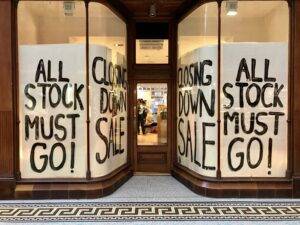
Almost 2,000 more British independent stores were left empty in the first half of this year, as small businesses struggled to cope with rising inflation and the cost of living crisis.
The biggest rise in vacancies in at least eight years marks a reversal in fortunes for independent outlets after two years of growth. Small firms had thrived from a shift towards local shopping prompted by the pandemic and were also helped by government Covid support on rent and business rates.
The loss of 1,915 outlets across high streets, shopping centres and retail parks this year unwinds most of the 1,335 net openings in the first half of last year and 804 during the same period in 2021, according to research by the Local Data Company (LDC).
Hairdressers were the hardest hit, according to LDC, with anet loss of 389 businesses. Estate agents, pubs, fish and chip shops, florists, butchers, newsagents and car dealerships also suffered.
However, the number of barbers, beauty salons and convenience stores continued to expand as demand for cheap treats on the return to offices, schools and socialising increased sales. Independent vape shops and health clubs are also thriving.
The north-east of England and Yorkshire were the worst-hit regions for independent closures, while Greater London fared the best.
Lucy Stainton, the commercial director at LDC, said: “In this year’s macroeconomic environment, it’s our independent businesses that have suffered, especially those high-energy consuming businesses such as hairdressers and pubs.
“We have also seen a decline in independent estate agents as the housing market slowed against a backdrop of rising interest rates. And with newsagents struggling to compete with the increase in convenience stores and their broader offering, this was another subsector to struggle in the first half.”
Stainton said the slew of independent businesses that started up during the pandemic were less likely to have the cash reserves to withstand the economic challenges of high cost inflation and tightening consumer spending, especially as they had not been trading for very long. Their difficulties have been worsened by a slowdown in government support.
Martin McTague, the national chair of the Federation of Small Businesses, said: “We saw a flourishing of new businesses conceived during the pandemic, which was a real bright spot in a turbulent time, as people suddenly had a chance to put long-held dreams or flashes of inspiration into practice.
“These new additions helped to counterbalance the businesses that sadly had to close as the economic disruption took its toll. News that many of these newer businesses in turn are encountering difficult trading conditions is worrying but not surprising given the huge challenges facing the retail, hospitality and leisure sectors.”
Meanwhile, it emerged that a net total of 2,000 chain stores had been left vacant in the first half of this year, a similar number to a year before. In all, there are now 4,000 more vacancies in British shopping destinations than last year, taking the vacancy rate to 13.9%, up from 13.8% a year ago.
LDC found there had been a 27% rise in retail and leisure sites being demolished for redevelopment, reflecting an increasing effort to repurpose space that has been vacant for long periods.
A total of 41% of Debenhams stores are still vacant with no confirmed plans. That is also the case for half of Philip Green’s collapsed Arcadia empire’s stores. The collapse of the budget chain Wilko last month is also expected to leave more gaps on Britain’s high streets.
Read more:
Almost 2,000 more independent stores across the UK are left empty this year




